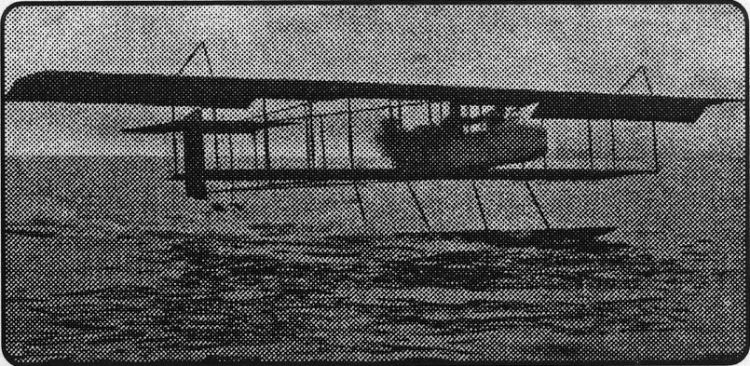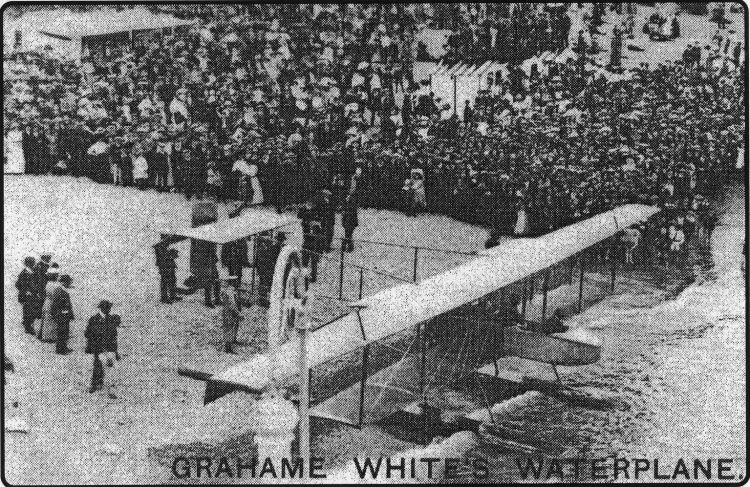
Published 5 July 2001

Flying circus
NEARLY 90 years ago advances in aviation, which was still in its infancy,
came thick and fast and residents in East Kent had a grandstand
view of many flying events.
Despite the hilly nature of the landscape the area was covered with small
air strips or landing fields where little aircraft, which only required a
short runway, could easily take off and land.
Local airfields, beaches and harbours had their share of visits by the
"flying circus" of airmen showing off their daring and skills in the air -
and on the sea.
A great variety of seaplanes, or "hydro aeroplanes" as the new Henry Farman
"water planes" or "hydroplanes" were called in 1912, were to be seen both at
Folkestone and Dover Harbour.
Bi-planes bearing a marked similarity to Louis Bleriot's little aeroplane -
a monoplane — in which he made the first ever flight across the Channel, in
1908, and the Wright Brothers' aircraft in which Rolls soon after made the
first I there-and-back flight, were soon being fitted with floats and taking
off from, and landing on water.
As early as 1911 efforts were being made in England to raise £1,000 to match
a similar sum from the French port, for flights across the Channel between
Folkestone and Boulogne by seaplane, with passengers.
So I was delighted when Memories page reader Jean Maynard, of Dover, just
before she died recently, showed me some of her family pictures which
included postcards of aviation pioneer Claude Grahame White with his "waterplane"
that he was demonstrating around the coast.
Unfortunately, having been kept as a souvenir.
the postcard had no postmark giving a date.
"Shortly afterwards, quite by chance, while searching newspaper files for
our feature "From Our Files" I happened to come upon a copy of the
Folkestone Herald for July 13, 1912 and spotted the small headline "HYDRO
AEROPLANE FEATS, by Grahame White, Great Pier Attraction," announcing a
colourful event at the port being promoted by Robert Forsyth, the go-ahead
managing director of the old Victoria Pier.
He was staging an Aeroplane Carnival with firework display and, with the
consent of Lord Radnor, a large marquee was being put up on the beach to
serve as a hangar for two new Henry Farman 'waterplanes.'
Bought by the Daily Mail newspaper, these seaplanes were to be demonstrated
by Grahame White and his team of airmen.
Mr Forsyth told the Herald that Grahame White would not only take off from
one side of the Victoria Pier, fly over it and alight on the water on the
other side - to the delight of crowds lining the pier - but would be
offering to give local people the chance to experience flying for the first
time, taking them up as paying passengers.
String of mishaps
One of the aircraft would be the same one in which White had flown over the
town a few days before on a flight from France.
This was described as a new military Farman biplane, a convertible with 70hp
Gnome engine. Fitted with interchangeable floats and wheels, it could land
and take off on sea or land and was seen as having great potential.
But it had two mishaps on the way to England. While flying over France there
was first an engine misfire and then a cylinder seized up at Abbeville on
the next stage of the flight and a new cylinder had to be sent for, from
Paris.
Then fog postponed the Channel flight. And fog again hit the airman on his
40 minute crossing, forcing him to come down near Dymchurch not knowing
where he was!
Setting off for Folkestone, he stopped en route at Hythe for more petrol and
arrived in five minutes short of two hours since setting off from Boulogne.
Claude was shadowed across the Channel by his wife, Mrs Grahame White,
sailing in the yacht Majesta.
Once hauled ashore the 'hydroplane' had its floats removed and wheels fitted
for an overland flight to Hendon, the operation attracting big crowds on the
beach and on top of the Leas, who
had never seen such an aircraft before.
Somehow White took off using his land wheels - from the shingle beach
according to the Herald editorial comment - and "soared up like a bird" over
the Leas. He then turned inland and headed for a field in the centre of the
West Cliff estate, where he landed to pick up his mechanic, attracting
another large crowd.
Mrs White, this time travelling separately by car, with friends saw him off
- hopefully on his way to Hendon. But it was not to be. There was engine
trouble again and an unscheduled stop had to be made near Sidcupl And all
this on the newly wed Grahame White's honeymoonl
TWO VIEWS of Grahame White's "waterplane" - possibly one photograph showing
a beach scene taken at Folkestone. The date is 1912.

 |
Call for revival of regatta - once 'event of the year’
*1 QH1 WRITER Felix was calling for revival J.«7vX of the once great
spectacle of Folkestone Regattas of the past, pointing out that the time
to act was before the summer season got underway. Once, he wrote, it was
the event of the year. And, he said, the town had an appropriate
figurehead in the present Mayor, himself a lover of boating and
swimming. In fact, he said, he recalled the day Matthew Webb, the first
man to swim the Channel, in 1875, presented a swimming prize to the
Mayor years ago. He also observed what a wonderful grandstand the town
had in the Leas for such a Regatta. Under the heading of “Other glimpses
into the long ago” Felix also told, a century ago, of an ancient news
sheet of the 1600s called “Mercurus Demo-cretus" which related the
unlikely tale of the discovery of a “perfect mermaid" driven ashore by a
“greate wind” near Greenwich, and, which, after shedding “copious pearly
tears” swam away againl Cheese-paring was how the editor greeted news
that Hythe Council had decided to pin its faith in moonlight for street
lighting in summer!
|
Massive objections to latest bus fare increase
>4 ftr<| STRONG objections to bus fare rises JL931 by the East Kent Road
Car Co, said to have reserves of £1,250,000, came from 18 local
authorities and 16 other objectors at a hearing in Canterbury. And so
many points were raised the licensing authority postponed a decision for
a week. For the company it was stated that every effort was being made
to arrest a decline in revenue and tackle rising costs to avoid big
Increases In fares. It claimed it was not possible to make use of
reserves. And, it was stated, the company relied on summer trade to meet
winter losses. At New Romney local councillors elected Alderman J Allen
Wiles the mayor for the six successive year. Roger Duncalfe, 66, of
Hillside Street, Hythe, was knighted in the King's Birthday Honours
List. A local resident: since 1937, he was the Chairman of British Glues
and Chemicals Ltd, a company he founded in 1920. He was also chairman of
the British Standards Institution. Townsman, writer of a light-hearted
diary column, was studying a copy of the Morning Advertiser newspaper,
of February 8. 1794 which told of ihe guillotine still being used in
France by the Revolutionary Tribunal to execute loyalists.
|
Herald man loops the loop in flying display at Capel
1 HERALD carried photographs 75
aL*7«aOyears ago of stunt flying and an aviation accident in which a
Dutch aircraft crash-landed at Seabrook. The picture of the lattor
depleted mechanics working feverishly to remove the Fokkcr aircraft's
engine before the tide came in! (It was quite by accident that I chose
to feature Grahame White’s “flying circus” at Folkestone in 1912 In
Memories this week. There was also a report on the same page with trhe
headline “A Herald representative loops the loop,” which told of a
fourpenny ride to the Valiant Sailor in June 1926 when you could taste
the thrills of flying for as little as five shillings (25p) in an Avro
aircraft or, for 15 shillings, you could even loop the loop! And you
could also watch a wing-walking stunt. The Revd FS Fischer, of Hythe was
about to make a short journey to take over as Rector of St Martin's,
Cherlton. Felix wrote of the origins of the Black Bull Hotel and of an
early painting he had seen which depicted the tumble-down original
hostelry surrounded by nothing but bare fields. Some of the ancients, he
wrote, had shook their heads at the decision to go ahead and build a new
public house there but it had become the centre-point of a whole new
township built around it
|
Airfield pop festival scheme rocks village of Hawkinge
«< POP FESTIVAL plan rocks village, screamed
I Othe headline on the Herald's lead story 25 years ago which told of
proposals for a three-day event at Hawkinge airfield in August. Entry
was to be limited to 40,000. Amplifiers were to pump out pop music for
12 hours a day and Pop idol David Essex - it was hoped - would be there
along with The Glitter band, Showaddy-waddy, Alvin Stardust and other
groups. Local people were horrified by the plans of promoter Colin
Barden, 28, managing director of International Promotions, of
Gillingham. He insisted that his festival would “not be one of those
drug-crazed hippy events” that made national headlines. Estimated cost
of organising the event was £150,000. Hawkinge parish council chairman
Charles Harker was among the objectors on the grounds of “the noise,
filth and people it would attract.” His wife Ruth commented: “This
festival just wouldn’t be welcome here. With 40,000 people there you
would only need 50 to give the event a bad name. You just can't control
them.” But local butcher Peter Holland, former vice-chairman of the
council said lots of pop festivals had been held with no trouble at all.
It was the publicity, he said, which often caused trouble. An
independent councillor made a lone stand against his Folkestone
colleagues accepting cash for attending meetings |
|



